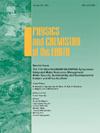作为新型吸附剂装饰在氧化石墨烯和石墨烯纳米颗粒活性炭上的鞭毛藻、掌形藻和囊状湖藻微藻细胞去除水中的铅
IF 3
3区 地球科学
Q2 GEOSCIENCES, MULTIDISCIPLINARY
引用次数: 0
摘要
工业化导致了大量废物的产生,这些废物含有各种有毒重金属,如铅(Pb)。在这项工作中,新型生物纳米结构石墨烯基微藻类纳米杂化吸附剂使用了三种不同类型的 Haematococcus lacustris 细胞(即鞭毛藻(flg-C)、棕榈藻(Pal-C)和囊藻(Cyst-C)),以引入更多的功能分子并增强纳米杂化吸附剂的表面特性。研究表征了用海藻细胞修饰的纳米氧化石墨烯活性碳(GO-AC@algae)和用海藻细胞修饰的石墨烯纳米片状活性碳(GNPs-AC@algae)纳米杂化物,并将其用于去除铅离子。GO-AC@algae 纳米杂化物的除铅效率高达 98.0% 以上,而 GNPs-AC@algae 纳米杂化物的除铅效率则超过 85.0%。在 GO-AC@algae 纳米杂交种中,具有囊胞的纳米杂交种(GO-AC@Cyst-C)因其高比表面积、丰富的氧氮基官能团、亲水性和孔隙结构而显示出作为吸附剂从水溶液中去除 Pb2+ 离子的显著功效。研究发现,化学吸附对 GO-AC@algae 和 GNPs-AC@algae 样品来说都是一个有益的过程,Pb2+ 被单层吸附在均匀的材料表面上。在各种吸附剂中,根据 Langmuir 模型,GO-AC@Cyst-C 的单层吸附容量最高,达到 25.58 mg/g,是最有效的纳米吸附剂。动力学研究表明,二阶动力学模型更好地描述了 GO-AC@algae 的吸附机理。同时,一阶动力学模型也适用于 GNPs-AC@algae 样品。这种纳米杂化物可作为更环保的吸附剂用于工业规模的废水处理,而且不会产生高昂的成本。本文章由计算机程序翻译,如有差异,请以英文原文为准。
Flagella, palmella and cyst Haematococcus lacustris microalgae cells decorated on graphene oxide and graphene nanoplatelets-activated carbon as novel adsorbents for the removal of lead from water
Industrialization has led to generation of large quantities of waste which constitutes various toxic heavy metals such as lead (Pb). In this work, novel bio-nanostructured graphene-based microalgae nanohybrid adsorbents, using three different cell types of Haematococcus lacustris (i.e., flagella (flg-C), palmella (Pal-C) and cyst (Cyst-C)) to introduce more functional moieties and enhance the surface properties of the nanohybrids. The nanostructured graphene oxide-activated carbon modified with algae cells (GO-AC@algae) and graphene nanoplatelets-activated carbon modified with algae cells (GNPs-AC@algae) nanohybrids were characterized and used for the removal of Pb ions. The GO-AC@algae nanohybrids demonstrated a high lead removal efficiency of over 98.0%, whereas the GNPs-AC@algae nanohybrids achieved more than 85.0%. Among the GO-AC@algae nanohybrids, the nanohybrid with cyst cell (GO-AC@Cyst-C) shown remarkable efficacy as an adsorbent for the removal of Pb2+ ions from aqueous solutions due to its high specific area, abundance of oxygen-nitrogen-based functional moieties, hydrophilicity, and pore structure. Chemisorption was found to be a beneficial process for both GO-AC@algae and GNPs-AC@algae samples, where Pb2+ was adsorbed in a single layer onto the uniform material surface. Among the various adsorbents, GO-AC@Cyst-C achieved the highest monolayer adsorption capacity of 25.58 mg/g according to the Langmuir model, making it the most effective nanoadsorbents. Kinetic studies revealed that the sorption mechanism of GO-AC@algae were better described by the second-order kinetic model. Meanwhile, the first-order kinetic model was found to be suited for GNPs-AC@algae samples. The nanohybrids could be employed as greener adsorbents at industrial scale for wastewater treatment without incurring significant costs.
求助全文
通过发布文献求助,成功后即可免费获取论文全文。
去求助
来源期刊

Physics and Chemistry of the Earth
地学-地球科学综合
CiteScore
5.40
自引率
2.70%
发文量
176
审稿时长
31.6 weeks
期刊介绍:
Physics and Chemistry of the Earth is an international interdisciplinary journal for the rapid publication of collections of refereed communications in separate thematic issues, either stemming from scientific meetings, or, especially compiled for the occasion. There is no restriction on the length of articles published in the journal. Physics and Chemistry of the Earth incorporates the separate Parts A, B and C which existed until the end of 2001.
Please note: the Editors are unable to consider submissions that are not invited or linked to a thematic issue. Please do not submit unsolicited papers.
The journal covers the following subject areas:
-Solid Earth and Geodesy:
(geology, geochemistry, tectonophysics, seismology, volcanology, palaeomagnetism and rock magnetism, electromagnetism and potential fields, marine and environmental geosciences as well as geodesy).
-Hydrology, Oceans and Atmosphere:
(hydrology and water resources research, engineering and management, oceanography and oceanic chemistry, shelf, sea, lake and river sciences, meteorology and atmospheric sciences incl. chemistry as well as climatology and glaciology).
-Solar-Terrestrial and Planetary Science:
(solar, heliospheric and solar-planetary sciences, geology, geophysics and atmospheric sciences of planets, satellites and small bodies as well as cosmochemistry and exobiology).
 求助内容:
求助内容: 应助结果提醒方式:
应助结果提醒方式:


